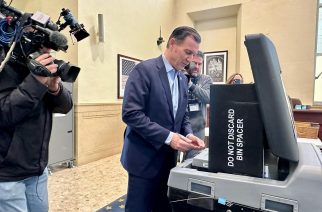
Under the recently adopted budget, tax cuts, tax credits and investments in education are all apart of Gov. Andrew Cuomo’s goal to revive the middle class and give millennials an incentive to invest their future in New York.
“With this budget, New York is once again leading the nation and showing what responsible government can achieve,” Cuomo said. “The result is a budget that advances the core progressive principles that built New York: investing in the middle class, strengthening the economy and creating opportunity for all.”
Just days after the budget was passed in Albany, Cuomo made stops around the state on Tuesday and Wednesday to deliver his message upstate and downstate.
“We’re going to get the economy moving and especially focus on the middle class,” Cuomo said in Rochester.
Cuomo’s Middle Class Recovery Act, enacted in the 2017-2018 budget, maintains the 2 percent property tax cap, which he says gives citizens the power to control the cost of local government.
“We believe this is going to be a way to bring democracy to bear on the issue of property tax,” Cuomo said.
The typical New Yorker pays two and a half times more in property tax than state income tax.
“I am obsessed with property taxes…the number one tax in New York has nothing to do with the state” Cuomo said in Buffalo. “We have to get property taxes down. They’re the highest in the nation.”
Cuomo’s Middle Class Recovery Act will also phase in personal income tax reductions.
Taxpayers in the $40,000-$150,000 income bracket will eventually pay a rate of 5.5 percent when it is phased in over the next seven years, dropping down from the current 6.45 percent rate adopted in 2012. The $150,000-$300,000 income bracket will drop to a rate of 6 percent from 6.65 percent.
“We’re going to cut taxes for the middle class, because they’re the ones who are struggling,” Cuomo said. “This budget passes a middle class tax cut average saving $700 per family less in New York state taxes this year as our way of saying, ‘We get it.’”
The budget also includes a free public college tuition program for middle class families making up to $100,000 annually beginning in the fall of 2017, eventually reaching families making $125,000 annually by the fall of 2019.
“If you care enough to work hard, we’re going to provide you a public education system that is second-to-none in the nation,” said Cuomo. “We will send you to college.”
Known as the “Excelsior Scholarship,” the program extends the state’s existing aid programs, including the Tuition Assistance Program and applicable federal grants, and fills in any remaining gaps to cover the full cost of tuition.
“The economies that are thriving [in New York] are the economies in partnership with higher learning,” Cuomo said in Rochester.
It increases Education Aid by $1.1 billion, including a $700 million increase in Foundation Aid, bringing the new Education Aid total to $25.8 billion or an increase of 4.4 percent.
“If your child has the talent, and your child is willing to work, your child can be a success,” Cuomo said in Buffalo. “That’s what this nation is all about; that’s what this state is all about.”
The budget also includes an over $800 million investment in prekindergarten to expand half-day and full-day prekindergarten for three- and four-year-old children in high-need school districts.
There is also an increase of $50 million to transform high-need schools into “community hubs” that will offer before-and-after school programs, summer learning activities, medical and dental care, and other social services.
“Tonight, there will be no child who puts their head on the pillow and wonder if they have a chance to make it,” Cuomo said in Queens.
The budget sets aside $35 million to create an additional 22,000 spots for students in after-school programs in poor districts statewide.
Finally, by enacting an enhanced middle class child care tax credit, the new tax credit will help more than 200,000 middle-class families make their child care more affordable.
The new tax credit would supplement the current New York State Child and Dependent Care Tax Credit, and more than double the benefit for families earning between $60,000 and $150,000, bringing the total credit from $169 to $376 per household on average.
“We believe in the concept of family and community and investing in each other, and we want to see you do well,” Cuomo said in Buffalo. “The greatest feast has the most people at the table.”









